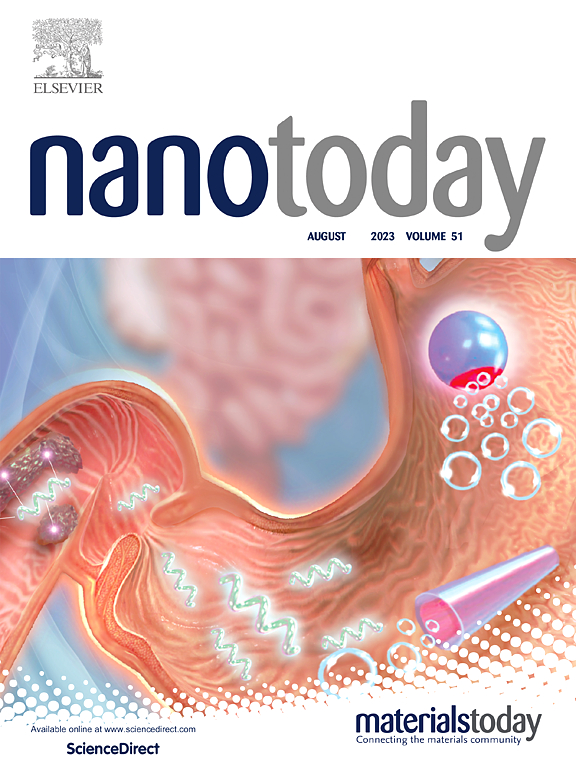光驱动电子皮肤激活钙通道,促进难治伤口愈合
IF 13.2
1区 材料科学
Q1 CHEMISTRY, MULTIDISCIPLINARY
引用次数: 0
摘要
难治性伤口的威胁日益严重,迫切需要探索新的修复材料和治疗策略。难治性创面内源电场的破坏可延长创面愈合时间。因此,应用外源性电刺激重建内源性电场可能是治疗难治性伤口的一种很有前途的方法。本文研制了一种由p型硅薄膜和近红外光组成的光驱动电子皮肤。该电子皮肤可以电调节细胞内钙离子振荡,显著促进成纤维细胞的粘附、增殖和迁移。其中,播种24次 h后,平均撒播面积比平面组高1.23倍。PES处理3 d后,细胞增殖量比平面组高117 %。在细胞迁移方面,PES治疗组创面完全愈合时间为48 h,对照组为76.47 ± 1.23。此外,采用电子皮肤源性光电刺激(PES)治疗糖尿病性皮肤全层圆形缺损,愈合速度快,治疗14天后创面基本愈合。促炎因子IL-1β、TNF-α表达水平降低。蛋白质组学分析表明,PES处理显著促进了代谢过程、细胞转运和分解代谢过程以及细胞运动。肌动球蛋白的转运和分解代谢过程可能受到mTOR信号通路的调控,细胞运动过程的增加可能导致肌动球蛋白收缩。这种光驱动的电子皮肤不仅为难治性伤口提供了一种简便的治疗策略和理论基础,而且为电刺激促进组织修复的潜在机制提供了新的见解。本文章由计算机程序翻译,如有差异,请以英文原文为准。
Photo-driven electronic skin enable activation of calcium channel for refractory wound healing
The growing threat of refractory wound has created imperative need for the exploration of novel repair materials and therapeutic strategies. The disrupted endogenous electric fields in refractory wound may prolong the healing process. Hence, apply exogenous electrical stimulation to reestablish endogenous electric fields may be a promising way for refractory wounds treatment. Herein, a photo-driven electronic skin consist of p-type Si thin-film and near-infrared light was developed. This electronic skin could electrically modulate the intracellular calcium oscillation and significantly promote the fibroblasts’ adhesion, proliferation and migration. Specifically, the average spreading area achieved 1.23 times higher than plane group after 24 h seeding. The cell proliferation quantity was 117 % higher than plane group after 3 days’ PES treatment. As for cell migration, the complete wound closure was observed at 48 h in all the PES treatment group compared to 76.47 ± 1.23 coverage area in control group. Furthermore, it demonstrated rapid closure rate of a full-thickness circular diabetic skin defects with photoelectric stimulation (PES) derived from electronic skin, the wound was almost healed at 14 days’ treatment. Furthermore, the expression level of pro-inflammation factors of IL-1β and TNF-α were reduced. Proteomic analysis showed that the metabolism process, the cellular processes of transport and catabolism, cell motility were remarkably promoted after PES treatment. The transport and catabolism process may regulate by mTOR signal pathway, and the increased cellular processes of cell motility may result of actomyosin contractility. This photo-driven electronic skin not only provided a facile therapeutic strategy and theoretical basis for refractory wound, but also provided a novel insight into potential mechanism underlying electrical stimulation promoting tissue repair.
求助全文
通过发布文献求助,成功后即可免费获取论文全文。
去求助
来源期刊

Nano Today
工程技术-材料科学:综合
CiteScore
21.50
自引率
3.40%
发文量
305
审稿时长
40 days
期刊介绍:
Nano Today is a journal dedicated to publishing influential and innovative work in the field of nanoscience and technology. It covers a wide range of subject areas including biomaterials, materials chemistry, materials science, chemistry, bioengineering, biochemistry, genetics and molecular biology, engineering, and nanotechnology. The journal considers articles that inform readers about the latest research, breakthroughs, and topical issues in these fields. It provides comprehensive coverage through a mixture of peer-reviewed articles, research news, and information on key developments. Nano Today is abstracted and indexed in Science Citation Index, Ei Compendex, Embase, Scopus, and INSPEC.
 求助内容:
求助内容: 应助结果提醒方式:
应助结果提醒方式:


